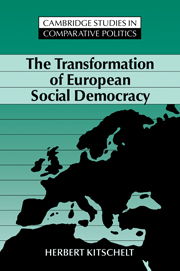Book contents
- Frontmatter
- Contents
- List of tables and figures
- Preface
- Glossary of political parties by country
- Introduction
- 1 Social structure and collective preference formation: Opportunities for left party strategy in the 1970s and 1980s
- 2 Class structure and left party performance
- 3 Political economy and left party fortunes
- 4 Social democratic strategy and electoral competition
- 5 Internal politics in socialist parties: Preference formation, aggregation, and strategic choice
- 6 The socialist discourse: Political semantics and party strategy
- 7 Social democracy in decline? Analytical and normative extensions of the argument
- References
- Index
1 - Social structure and collective preference formation: Opportunities for left party strategy in the 1970s and 1980s
Published online by Cambridge University Press: 08 January 2010
- Frontmatter
- Contents
- List of tables and figures
- Preface
- Glossary of political parties by country
- Introduction
- 1 Social structure and collective preference formation: Opportunities for left party strategy in the 1970s and 1980s
- 2 Class structure and left party performance
- 3 Political economy and left party fortunes
- 4 Social democratic strategy and electoral competition
- 5 Internal politics in socialist parties: Preference formation, aggregation, and strategic choice
- 6 The socialist discourse: Political semantics and party strategy
- 7 Social democracy in decline? Analytical and normative extensions of the argument
- References
- Index
Summary
People make history, but not under freely chosen conditions, and political parties are more than the passive reflection of collective demands and preferences originating in the prepolitical sphere of social relations. Politicians actively participate in shaping people's political views (“issue leadership”). Nevertheless, it is misleading to attribute the power to create political consciousness and action exclusively to the realm of politics. Both sociological determinism and political voluntarism shun a more complex reconstruction of the relationship between social structure and politics.
In this book I argue that politicians' strategies in intra- and interparty competition primarily determine their parties' electoral fortunes. Yet social and institutional settings structure the opportunities politicians may seize upon in the competitive process. Experiences in markets, work organization, and the sphere of consumption profoundly affect citizens' political aspirations and preferences. In order to promote their objectives, politicians must recognize such preferences. Is is only in the long run that public policies are likely to alter the social structure that affects citizens' everyday experiences and thus to induce a change in the process of popular preference formation itself.
In this chapter I first present a sociological theory of political preference formation in advanced capitalist democracies. My argument proceeds in three steps. I begin by delineating the range of preferences people may rank order in their most basic political choices. Next, I examine the social experiences that affect citizens' predispositions over the choice of fundamental preferences. Finally, I move from the micro-level of individual experiences to the macro-level of group formation and present hypotheses about the constitution of collective ideological currents that are centered around socioeconomic categories in contemporary society.
- Type
- Chapter
- Information
- The Transformation of European Social Democracy , pp. 8 - 39Publisher: Cambridge University PressPrint publication year: 1994
- 1
- Cited by

